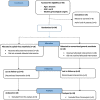The efficacy and safety of an adapted opioid-free anesthesia regimen versus conventional general anesthesia in gynecological surgery for low-resource settings: a randomized pilot study
- PMID: 36280804
- PMCID: PMC9589676
- DOI: 10.1186/s12871-022-01856-6
The efficacy and safety of an adapted opioid-free anesthesia regimen versus conventional general anesthesia in gynecological surgery for low-resource settings: a randomized pilot study
Abstract
Introduction: There is scarce data on the safety and efficacy of opioid-free anesthesia (OFA), in resource-limited settings due to the non-availability of dexmedetomidine, the reference OFA agent. We aimed to demonstrate the feasibility, efficacy and safety of a practical OFA protocol not containing dexmedetomidine, adapted for low-resource environments in very painful surgeries like gynecological surgery.
Methods: We conducted a randomized pilot study on ASA I and II women undergoing elective gynecological surgery at a tertiary care hospital in Cameroon. Patients were matched in a ratio of 1:1 into an OFA and a conventional general anesthesia (CGA) group. The OFA protocol entailed the intravenous (IV) magnesium sulfate, lidocaine, ketamine, dexamethasone, propofol, and rocuronium, followed by isoflurane and a continuous infusion of a calibrated mixture of magnesium sulfate, ketamine and clonidine. The CGA protocol was IV dexamethasone, diazepam, fentanyl, propofol, and rocuronium, followed by isoflurane and reinjections of fentanyl propofol and a continuous infusion of normal saline as placebo. The primary endpoints were the success rate of OFA, isoflurane consumption and intraoperative anesthetic complications. The secondary endpoints were postoperative pain intensity, postoperative complications, patient satisfaction assessed using the QoR-40 questionnaire and the financial cost of anesthesia.
Results: We enrolled a total of 36 women undergoing gynecological surgery; 18 in the OFA group and 18 in the CGA group. The success rate of OFA was 100% with significant lesser consumption of isoflurane in the OFA group, no significant intraoperative complication and better intraoperative hemodynamic stability in the OFA group. Postoperatively, compared to the CGA group, the OFA group had statistically significantly less pain during the first 24 h, no morphine consumption for pain relief, had less hypoxemia during the first six hours, less paralytic ileus, less nausea and vomiting, no pruritus and better satisfaction. The mean financial cost of this adapted OFA protocol was statistically significant lesser than that of CGA.
Conclusion: This OFA regimen without dexmedetomidine for a low-resource setting has a promising success rate with few perioperative complications including mild intraoperative hemodynamic changes, decrease postoperative complications, pain, and opioid consumption in patients undergoing elective gynecology surgery.
Trial registration: This study was registered at clinicaltrials.gov on 03/02/2021 under the registration number NCT04737473.
Keywords: Adapted; Cameroon; Efficacy; Gynecological surgery; Opioid-free anesthesia; Safety.
© 2022. The Author(s).
Conflict of interest statement
The authors declare that they have no competing interests.
Figures





Similar articles
-
Comparation Among Opioid-Based, Low Opioid and Opioid Free Anesthesia in Colorectal Oncologic Surgery.Pril (Makedon Akad Nauk Umet Odd Med Nauki). 2023 Mar 29;44(1):117-126. doi: 10.2478/prilozi-2023-0013. Print 2023 Mar 1. Pril (Makedon Akad Nauk Umet Odd Med Nauki). 2023. PMID: 36987755 Clinical Trial.
-
Opioid-free versus opioid-based anesthesia in major spine surgery: a prospective, randomized, controlled clinical trial.Minerva Anestesiol. 2024 Jun;90(6):482-490. doi: 10.23736/S0375-9393.24.17962-X. Minerva Anestesiol. 2024. PMID: 38869262 Clinical Trial.
-
Opioid free versus opioid sparing strategies for multimodal antinociception during laparoscopic colectomy: a randomised controlled trial.Anaesth Crit Care Pain Med. 2024 Dec;43(6):101436. doi: 10.1016/j.accpm.2024.101436. Epub 2024 Oct 9. Anaesth Crit Care Pain Med. 2024. PMID: 39393528 Clinical Trial.
-
Is opioid-free general anesthesia for breast and gynecological surgery a viable option?Curr Opin Anaesthesiol. 2019 Jun;32(3):257-262. doi: 10.1097/ACO.0000000000000716. Curr Opin Anaesthesiol. 2019. PMID: 31045633 Review.
-
Perioperative intravenous ketamine for acute postoperative pain in adults.Cochrane Database Syst Rev. 2018 Dec 20;12(12):CD012033. doi: 10.1002/14651858.CD012033.pub4. Cochrane Database Syst Rev. 2018. PMID: 30570761 Free PMC article.
Cited by
-
Effect of low-dose esketamine on cardio-biliary reflex and postoperative pain during laparoscopic cholecystectomy surgery: A randomized, controlled trail.PLoS One. 2025 Jun 2;20(5):e0321892. doi: 10.1371/journal.pone.0321892. eCollection 2025. PLoS One. 2025. PMID: 40455778 Free PMC article. Clinical Trial.
-
Effectiveness and safety of opioid-free anesthesia compared to opioid-based anesthesia: a systematic review and network meta-analysis.J Anesth Analg Crit Care. 2025 Aug 13;5(1):53. doi: 10.1186/s44158-025-00272-9. J Anesth Analg Crit Care. 2025. PMID: 40804649 Free PMC article.
-
The Performance of Opioid-Free Anesthesia for Bariatric Surgery in Clinical Practice.Obes Surg. 2023 Jun;33(6):1687-1693. doi: 10.1007/s11695-023-06584-5. Epub 2023 Apr 27. Obes Surg. 2023. PMID: 37106268 Free PMC article.
-
A nomogram to predict postoperative nausea and vomiting in the ward following laparoscopic bariatric surgery.Surg Endosc. 2023 Dec;37(12):9217-9227. doi: 10.1007/s00464-023-10483-2. Epub 2023 Oct 23. Surg Endosc. 2023. PMID: 37872426
-
Safety and effectiveness of multimodal opioid-free anaesthesia for pain and recovery after laparoscopic surgery: a systematic review and meta-analysis.BMJ Open. 2025 Mar 22;15(3):e085988. doi: 10.1136/bmjopen-2024-085988. BMJ Open. 2025. PMID: 40122555 Free PMC article.
References
-
- Prys-Roberts C, Kelman GR. The influence of drugs used in neuroleptanalgesia on cardiovascular and ventilatory function. Br J Anaesth. 1967;39(2):134–135. - PubMed
-
- Fawcett WJ, Jones CN. Bespoke intra-operative anaesthesia - the end of the formulaic approach? Anaesthesia. 2018;73:1062–1066. - PubMed
-
- Lee LA, Caplan RA, Stephens LS, et al. Postoperative opioid-induced respiratory depression: a closed claims analysis. Anesthesiology. 2015;122:659–665. - PubMed
-
- Joly V, Richebe P, Guignard B, et al. Remifentanil-induced postoperative hyperalgesia and its prevention with small-dose ketamine. Anesthesiology. 2005;103:147–155. - PubMed
Publication types
MeSH terms
Substances
Associated data
LinkOut - more resources
Full Text Sources
Medical
Research Materials

